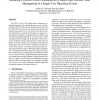Free Online Productivity Tools
i2Speak
i2Symbol
i2OCR
iTex2Img
iWeb2Print
iWeb2Shot
i2Type
iPdf2Split
iPdf2Merge
i2Bopomofo
i2Arabic
i2Style
i2Image
i2PDF
iLatex2Rtf
Sci2ools
MOBICOM
1996
ACM
1996
ACM
Reducing Processor Power Consumption by Improving Processor Time Management in a Single-user Operating System
The CPU is one of the major power consumers in a portable computer, and considerable power can be saved by turning off the CPU when it is not doing useful work. In Apple's MacOS, however, idle time is often converted to busy waiting, and generally it is very hard to tell when no useful computation is occurring. In this paper, we suggest several heuristic techniques for identifying this condition, and for temporarily putting the CPU in a low-power state. These techniques include turning off the processor when all processes are blocked, turning off the processor when processes appear to be busy waiting, and extending real time process sleep periods. We use trace-driven simulation, using processor run interval traces, to evaluate the potential energy savings and performance impact. We find that these techniques save considerable amounts of processor energy (as much as 66%), while having very little performance impact (less than 2% increase in run time). Implementing the proposed str...
| Added | 08 Aug 2010 |
| Updated | 08 Aug 2010 |
| Type | Conference |
| Year | 1996 |
| Where | MOBICOM |
| Authors | Jacob R. Lorch, Alan Jay Smith |
Comments (0)

